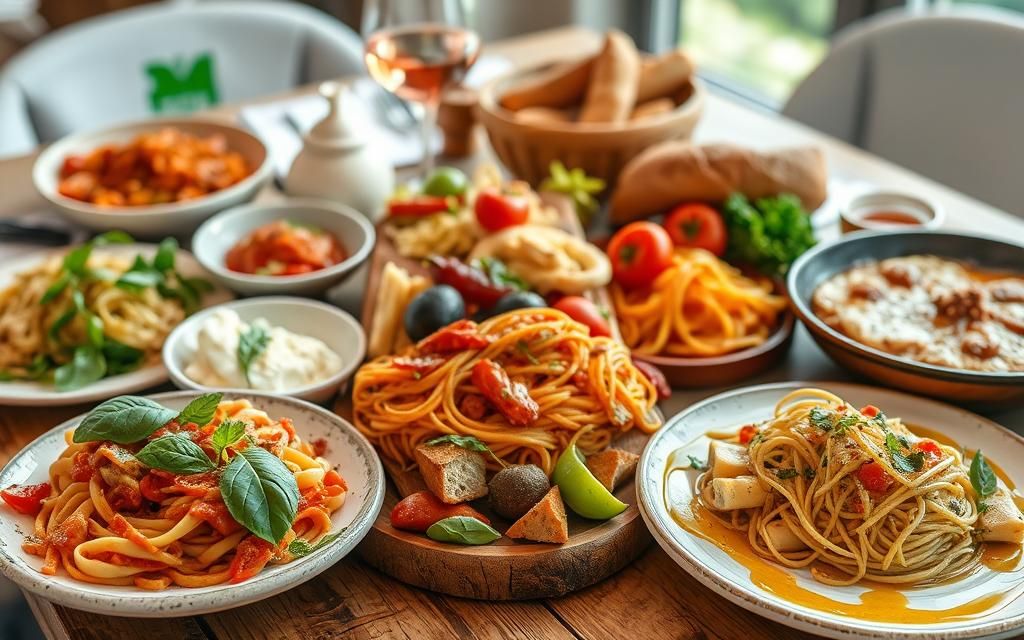Join us on a fascinating journey into Italian cuisine. We’ll explore from the North’s rolling hills to the South’s sunny shores. Discover the secrets of Italy’s famous dishes and the cultural forces that shaped them. Italian food is more than recipes; it’s a blend of creativity, passion, and tradition.
We’ll visit Italy’s different regions, each with its own flavors and techniques. Together, these elements make up the world’s view of Italian cuisine. Let’s dive into the history of this food culture, from ancient Rome to today. We’ll see how tradition and new ideas come together in every dish.
If you love food or just enjoy exploring new tastes, this journey is for you. We’ll take you to the Mediterranean’s heart, where you’ll find the sights, sounds, and smells of Italian dishes. Get ready to be moved by the stories and passion behind Italian cuisine, a true global culinary treasure.
Table of Contents
ToggleAncient Roots and Roman Influences
Italy’s food history goes way back to ancient Roman times. The Roman Empire spread across the Mediterranean, bringing new ingredients and cooking ways. These changes shaped the base of today’s Italian food.
The Culinary Foundation of Ancient Rome
The Romans ate a lot of wheat, olive oil, and grapes. They made dishes like pulmentum, a thick porridge, and farcimina, sausages. They also knew how to keep food fresh for a long time by salting, smoking, and pickling it.
Ingredients, Techniques, and Preservation Methods
- Wheat: A key food, used in breads, pastas, and porridges.
- Olive oil: Used for cooking, dressing, and keeping foods fresh.
- Grapes: Grown for wine, a big part of Roman food.
- Salting, smoking, and pickling: Old ways to keep food fresh still used today.
The impact of ancient Roman food on Italy’s cooking is huge. The Romans introduced ingredients, cooking methods, and ways to keep food fresh. These ideas helped create the rich and tasty Italian food we enjoy now.
Medieval Italy: The Rise of Regional Cuisines
In the Middle Ages, Italian food changed a lot. Different regions started to show their own unique tastes. This led to special foods and cooking ways. Each place had its own climate, geography, and farming methods.
Fragmentation and the Emergence of Local Traditions
After the Roman Empire fell, Italy split into many small states. Each had its own culture and food. From the north’s creamy dishes to the south’s seafood, regional food traditions began to stand out.
The Role of Monastic Orders in Culinary Innovation
Monastic orders became key in shaping medieval Italian cuisine too. Monks worked hard to make their own food. They tried new culinary techniques and ingredients. This made the regional food traditions even more varied.
This time of change and local food identity in Italy set the stage for today’s Italian cuisine.
The Renaissance: A Flourishing of Culinary Arts
The Renaissance brought a new era of culinary innovation and refinement to Italy. It was a time of artistic, scientific, and cultural growth. The rediscovery of ancient Greek and Roman texts made people interested in classical cuisine again. This led to a focus on fresh, seasonal ingredients and beautiful presentation.
Trade routes expanded, bringing exotic spices and ingredients from the East. This made Renaissance Italian cuisine even more diverse. New cooking techniques, like using sugar and refined methods, led to fancy dishes and desserts.
Chefs and food lovers became more creative during this time. They experimented with new cooking methods and utensils. This changed how food was made and presented.
Specialized food markets became popular, showing off artisanal foods. This made people proud of their regional foods and traditions. The sharing of ideas and techniques between regions made Renaissance Italian cuisine richer and more diverse.
The Renaissance’s impact on Italian food is still felt today. It taught the importance of quality ingredients, new cooking methods, and celebrating local food traditions. The culinary innovation of this era is why Italian food is loved worldwide.
The Influence of Immigration and Global Cuisine
Italian cuisine’s story is shaped by more than just its own history. It’s also shaped by the exchange of culinary ideas with other cultures. Immigrants from around the world have brought new tastes to Italy. This includes Arab traders in Sicily and immigrants from Eastern Europe and the Americas.
In the 19th century, French cuisine had a big impact on Italian cooking. It brought refined techniques and elegant ways of presenting dishes. Later, immigrants from Latin America introduced new ingredients and dishes to Italian cuisine. This mix of cultures has made Italian food vibrant and ever-changing.
Embracing Diverse Flavors and Techniques
Today’s diverse Italian food shows how open Italian chefs and cooks are to new ideas. They’ve taken spices and herbs from the Middle East and cooking methods from Asia. This has made Italian cuisine evolve and get more exciting.
This openness to new ideas has made Italian cuisine more interesting and loved worldwide. It has changed how we see and enjoy Italian food. Now, Italian cuisine is a mix of tradition and new ideas, offering a fresh culinary experience.
italian food culture
Italy is a country with a hundred cities and a thousand bell towers. It’s also home to a hundred cuisines and a thousand recipes. This variety shows a history shaped by regionalism and division. It has created a mosaic of Italian food culture instead of one single tradition.
From Sicily’s sunny shores to the Alps’ snowy peaks, each region has its own unique food culture. This diversity weaves a tapestry of flavors. It shows the country’s rich heritage through its food.
Every region in Italy has its own special dishes. You’ll find everything from the hearty dishes of Tuscany to the seafood of the Amalfi Coast. Lombardy offers delicate, creamy risottos. This variety makes Italian food culture rich and complex.
Walking through Italy’s streets and markets reveals a world of culinary treasures. These treasures reflect Italy’s history, traditions, and creativity. From simple, rustic tastes to sophisticated, new dishes, Italian culinary identity shows the power of regional cuisine diversity.

Northern Delights: Piedmont, Lombardy, and Veneto
In the northern parts of Italy, we find a world of diverse flavors. Piedmont, Lombardy, and Veneto each bring their own unique tastes to the table. From the elegant dishes of Piedmont to the creamy risottos of Lombardy and the varied dishes of Veneto, these regions highlight the rich variety of Italian cuisine.
The Refined Flavors of Piedmont
Piedmont is famous for its noble wines and white truffles. Its cuisine is both sophisticated and fulfilling. Dishes like Barolo-braised meats and ‘bagna cauda’ dip show off the region’s culinary traditions. These are paired with Barolo and Barbaresco wines, making for a memorable dining experience.
Lombardy’s Risotto and Lakeside Cuisine
In Lombardy, we find a focus on creamy risottos and freshwater fish. The ‘Risotto alla Milanese’ is a must-try, with its saffron and perfect texture. The region’s lakes offer dishes that highlight the freshness of local fish, showing off the area’s natural flavors.
Veneto’s Diverse Culinary Landscape
Veneto stretches from the Dolomites to the Adriatic Sea, offering a wide range of flavors. Its dishes, from ‘Risi e Bisi’ to ‘Sarde in Saor’, reflect its cultural mix and coastal position. Veneto’s food is a mix of tastes, tied to its long culinary history.
Exploring Piedmont, Lombardy, and Veneto reveals the depth of Northern Italian cuisine. Each area has its own flavor profile, adding to the rich variety of regional Italian food. This diversity makes Italian food a fascinating experience.
Central Traditions: Tuscany, Emilia-Romagna, and Lazio
As we explore Italy’s heart, we find a world of rich flavors. Tuscany’s hills, Emilia-Romagna’s plains, and Lazio’s streets each bring their own taste to the table. These regions show off the best of Central Italian cuisine.
The Rustic Charm of Tuscan Cuisine
Tuscany is famous for its simple, hearty dishes. Try the ‘Panzanella’, a salad with bread, tomatoes, and basil. Or enjoy ‘Ribollita’, a warm soup with vegetables and beans.
No trip here is complete without tasting ‘Bistecca alla Fiorentina’. This is a thick, grilled T-bone steak loved by many.
Emilia-Romagna: Italy’s Food Valley
Emilia-Romagna is known as the ‘Food Valley’ of Italy. It’s where many famous dishes come from. Taste the rich Parmigiano-Reggiano cheese, the tangy balsamic vinegar, and the delicious prosciutto di Parma.
This region celebrates slow food and high-quality ingredients. It’s a place where food is an art form.
Roman Classics and Coastal Delights
In Lazio, Rome’s food culture is alive with dishes like ‘Carbonara’, ‘Amatriciana’, and ‘Cacio e Pepe’. These pastas are simple yet full of flavor. They show the essence of Roman cooking.
Along the coast, Lazio offers seafood dishes. These show the region’s love for the sea and its tasty seafood.
The Southern Sun: Campania, Puglia, and Sicily
As we head to Southern Italy, the food gets more vibrant and full of Mediterranean flavors. Campania, known for Naples, is where Italian pizza was born. The famous ‘Pizza Margherita’ shows off the area’s love for fresh ingredients and balance.
Neapolitan Pizza and Buffalo Mozzarella
Neapolitan pizza is all about simplicity and quality. It has a thin crust and just a few toppings. The star of this pizza is the creamy buffalo mozzarella from lush green pastures. This cheese makes the classic Pizza Margherita a hit around the world.
Puglia’s Peasant Traditions and Mediterranean Influences
In Puglia, at Italy’s southern tip, food is all about simple, hearty dishes. Legumes, veggies, and olive oil are key ingredients. Dishes like ‘Orecchiette con Cime di Rapa’ and ‘Insalata di Rucola e Pomodori’ show off Puglia’s love for the land and sea.
Sicily: A Culinary Crossroads
Sicily is a place where many cultures meet, making its food unique. From ‘Caponata’ to ‘Arancini,’ Sicilian dishes mix flavors and traditions. This mix of cultures makes Sicilian food as exciting as the island itself.
Modern Italian Cuisine: A Celebration of Tradition and Innovation
In the world of Italian cuisine, we see a mix of culinary tradition and innovation. Classic recipes and techniques are still the base. But today’s chefs are adding new twists to old dishes with creativity.
At the core of this change is a big push for sustainable Italian food. Chefs are choosing local, high-quality ingredients. They work closely with farmers and producers. This approach makes the food taste better and helps protect Italy’s farming traditions.
From simple ‘cucina povera’ dishes to fancy Michelin-starred meals, Italian cuisine today is diverse. New cooking methods like molecular gastronomy mix with old traditions. This creates dishes that are exciting and true to Italian food culture.
Enjoying a hearty Italian food meal or admiring a modern dish’s presentation is a treat. The blend of tradition and innovation in contemporary Italian cuisine delights food lovers everywhere. It keeps Italy at the top of the culinary world.
The Impact of Regional Italian Cuisine on Global Gastronomy
Italian cuisine has touched the hearts of food lovers worldwide. From Lombardy’s fragrant risottos to Naples’ tasty pizzas, Italy’s regional dishes have made a big mark globally. This shows the country’s diverse climate, geography, and history, which shape its unique flavors and traditions.
The world’s love for Italian cuisine has grown as we’ve become more connected. Chefs and home cooks now explore Italy’s food traditions, discovering the culinary diversity it offers. Each region, from Emilia-Romagna’s hearty stews to Sicily’s seafood, brings its own taste to the table.
Italy’s regional cuisines are now more popular worldwide. Artisanal producers and chefs share the stories behind these dishes, highlighting Italy’s rich culinary heritage. This has led to new interpretations and reinventions of Italian cuisine, celebrating its diversity.
The global love for Italian cuisine has also deepened our connection to food, culture, and identity. By diving into regional Italian dishes, people worldwide have learned more about Italy’s history, geography, and traditions. This has led to a greater respect for food’s role in culture and identity.
As we celebrate Italian cuisine‘s global impact, it’s clear its regional food traditions will stay important in the world’s culinary scene. From Piedmont’s hills to Sicily’s shores, Italy’s flavors will keep inspiring and spreading the joy of good food everywhere.
Conclusion
Exploring Italy’s regional cuisines is like a journey through time and space. Each region shows us the local culture, history, and way of life. It enriches our understanding of cuisine in Italy.
From Piedmont’s refined tastes to Tuscan cuisine’s rustic charm, Italy’s regional diversity is clear. Puglia’s Mediterranean flavors and Sicily’s mix of cultures show the country’s evolving food scene. These regions tell stories of tradition and innovation in Italian cuisine.
Looking ahead, Italian cuisine is embracing both tradition and modern innovation. Chefs and home cooks are making new dishes with global flavors. They keep the essence of Italian food alive while trying new things. This mix of old and new keeps Italian cuisine exciting for food lovers everywhere.
FAQ
What are the key ingredients and cooking techniques that define ancient Roman cuisine?
Ancient Roman cuisine was shaped by Mediterranean cultures. It used wheat, olive oil, and grapes a lot. They also used salting, smoking, and pickling to preserve food, which still affects Italian cooking today.
How did the fragmentation of Italy during the Middle Ages contribute to the development of regional culinary traditions?
When Italy split into city-states in the Middle Ages, different cooking styles emerged. The north focused on dairy, while the south loved seafood. This led to unique foods across the country.
What was the impact of the Renaissance on Italian cuisine?
The Renaissance brought new life to Italian cooking. It made people interested in ancient Greek and Roman food again. This led to a focus on fresh ingredients and beautiful presentation. Exotic spices from the East also made Italian food more exciting.
How have waves of immigration influenced the evolution of Italian cuisine?
Immigrants from around the world have changed Italian food. Arabs brought spices to Sicily, while immigrants from Eastern Europe and the Americas introduced new dishes. This has made Italian food richer and more diverse.
What are some of the key characteristics of northern Italian cuisine?
Northern Italian food is known for its rich, buttery dishes. Piedmont is famous for its truffle dishes and Barolo wines. Lombardy is known for creamy risottos and fish from freshwater lakes. Veneto’s food reflects its varied landscapes with dishes like ‘Risi e Bisi’ and ‘Sarde in Saor’.
How does the cuisine of central Italy differ from that of the north and south?
Central Italy’s food is simpler but full of flavor. Tuscany is known for ‘Panzanella’ and ‘Ribollita’, and the famous ‘Bistecca alla Fiorentina’. Emilia-Romagna is famous for Parmigiano-Reggiano cheese and prosciutto. Lazio is home to classic Roman dishes like ‘Carbonara’ and ‘Cacio e Pepe’.
What are the distinctive features of southern Italian cuisine?
Southern Italian food is full of Mediterranean flavors. Naples is famous for ‘Pizza Margherita’, showing off fresh ingredients and balance. Puglia focuses on legumes and olive oil. Sicily’s dishes like ‘Caponata’ and ‘Arancini’ reflect its diverse culture and history.
How has modern Italian cuisine evolved while still maintaining its traditional roots?
Modern Italian food keeps its traditional roots but is always changing. Chefs are making new versions of classic dishes with fresh ingredients. They focus on local, sustainable food, keeping Italian cuisine vibrant and connected to its heritage.
What is the global impact of Italy’s regional culinary diversity?
Italy’s regional foods have changed how people see Italian food worldwide. Each region’s unique ingredients and dishes show off Italy’s varied climate and history. This has made chefs and food lovers appreciate Italy’s regional foods more, showing the depth of Italian cuisine.
















